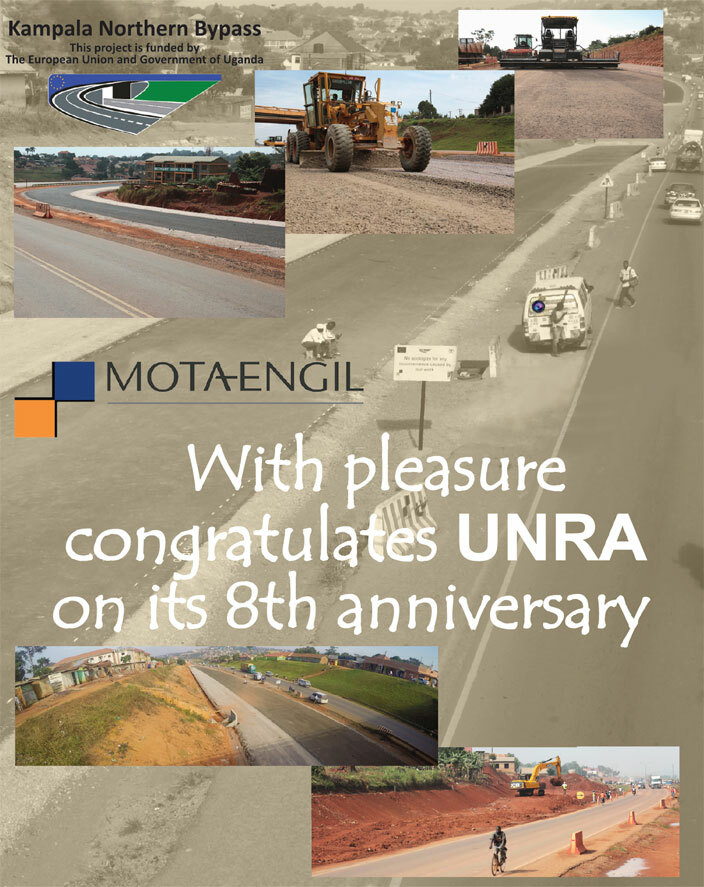UNRA's eight-year journey
UNRA Supplement
By Gilbert Kidimu
Road transport is, by far, the most dominant mode of transport in Uganda, carrying over 95% of passenger and freight traffic. National roads currently make up about 25% of the road network, but carry over 80% of the total road traffic.
They also provide vital transport corridors to the land-locked countries of Rwanda and Burundi to parts of Eastern DR Congo and Southern Sudan, to the sea. However, out of the 20,000km of the national roads, only 15% (2914km) is paved or tarmac.
The Uganda National Roads Authority (UNRA) is a Government agency established by an Act of Parliament — the Uganda National Authority Act of 2006 — and became operational in 2008. The mandate of UNRA is to develop and maintain the national roads network, advise the Government on general roads policy and contribute to addressing transport concerns, among others.
UNRA is governed by a ninemember board of directors, chaired by Angela Kanyina Kiryabwire. Its executive director is Allen Kagina. UNRA is a result of road sector reforms. In 1996, the Government of Uganda prepared the 10-Year Road Sector Development Programme.
The Programme was reviewed and updated in 2002, making it a 10-year rolling road sector development programme Phase II. One of the objectives of the road sector development programme was establishing a robust administration for effective and efficient management of the national roads network.
To achieve this objective, the Government committed itself to reform national roads management through the establishment of an autonomous performancebased road authority. The authority would handle road administration and execution function and restructuring the Ministry of Works and Transportation to focus on policy, standard setting, regulation, monitoring and evaluation functions.
The UNRA Act
As part of the reform process, in 1998, the Road Agency Formation Unit was created as a semi-autonomous agency within the works ministry to manage the development of national roads. In 2002, a study was conducted on the establishment of an autonomous roads authority.
The findings of the study informed the drafting of the Bill for creating the Uganda National Roads Authority. The Bill was passed by Parliament in May 2006 and was signed into Law by President Yoweri Museveni in June 2006 and the Board of Directors appointed in January 2007. Thereafter, the executive director was appointed in November 2007. UNRA became fully operational on July 1, 2008.
Road Network
By June 2009, the national roads network was estimated at 10,000km. In July 2009, the Government doubled the national roads network by taking over an additional 10,000km of the district roads network. This increased the national roads network to about 20,000km.
UNRA's Mandate
Some of UNRA's responsibilities include the management of the national roads network (about 20,000km), maintenance and development of the national roads network, advising the Government on policy matters concerning roads and assisting in co-ordination with relevant ministries, departments and agencies of Government.
The authority is also responsible for linking ferries to the national roads and managing the axle load control. UNRA also collaborates with international organisations, inter-government organisations and agencies of other states and the private sector on issues relating to the development and maintenance of roads.
The body also enters into agreements or other arrangements with any person for the provision of roads services, subject to such charges as may be agreed. They also assist the works and transport minister on matters related to the planning, design, construction and maintenance of roads, whether the roads are part of the national roads network or not; and establishing and maintaining road reserves.
Completed projects
During the first five years of the agency, the road network increased from 10,800km to 21,000km. According to a published report in July 2015, 4,000km (19%) of the 21,000km national road network was paved. A total of 1,500km of roads were improved from gravel to bituminous surface between 2005 and 2010. A total of 5,000km of roads are earmarked for tarmacking before December 2016.
Jinja-Bugiri road
UNRA has overseen the reconstruction of the Jinja- Bugiri Road (72km). This is a key section on the Northern Corridor Route linking Uganda to the Sea. The project was funded by EU and the government of Uganda.
Northern bypass
The construction of Kampala Northern Bypass intended to decongest Kampala City by diverting transit trucks heading to Western Uganda, Rwanda and the eastern DR Congo. This project was funded by the EU and the Government. The project was substantially completed and opened to the public in 2009.
Lira road
Lira Road is a 123km link part of the Trans African highway supposed to link the East Africa Coast to the West Africa Coast. It was jointly funded by World Bank and the Government. The works were completed by June 2010, 4 months ahead of schedule.
Masaka-Mbarara road
Before 2008, the Masaka- Mbarara road was in a poor state. That same year, the Government, using funds borrowed from the EU, began upgrading the road to grade II bitumen surface with shoulders, culverts, and drainage channels. The work was contracted to Reynolds Construction Company of Nigeria at a cost of sh230b.
Others
Other roads that have been completed include Fort Portal-Bundibugyo-Lamia Road, Gayaza-Ziroobwe road, Matugga-Kapeeka road, Jinja- Bugiri road, Kampala-Mityana road, Kazo-Ibanda-Kamwenge road, and Nyakahita-Kazo road.
ongoing projects
|
